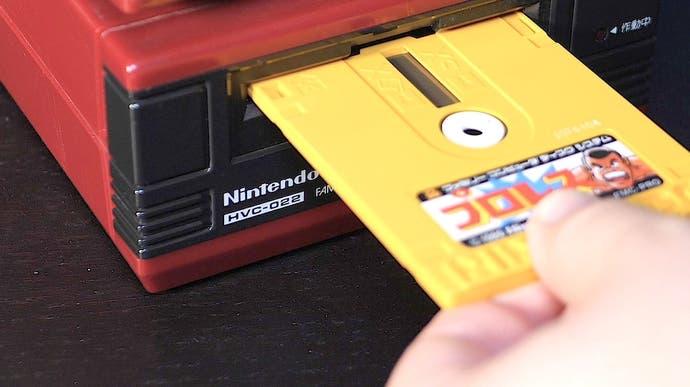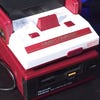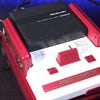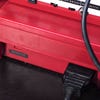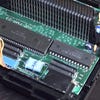Revisiting the Famicom Disk System: mass storage on console in 1986
What was the Japan-only Nintendo upgrade actually like?
In Western countries, the era of the console was effectively dead by the mid-1980s, with a flourishing home computer scene replacing it - but the situation was very different in Japan. Nintendo's Famicom system was starting to flourish and while primarily cartridge-based, ideas from the home computer would crossover into the console world, resulting in the Famicom Disk System - or FDS - which did exactly what it said on the tin, offering disk-based software to run on the console we would eventually come to know as the Nintendo Entertainment System.
The system launched in Japan only, debuting in 1986 - three years after the Famicom itself. The unit could sit beneath the main console, attached to the unit via a serial cable that connected to a ROM cartridge that sits in the Famicom's cartridge slot. The ROM cartridge contained 32K of memory, 8K of CHR RAM along with an IO chip that also fed extra sound channels to the console via bespoke pins on the cartridge slot among other things. Interestingly, while the FDS could be powered by an AC adaptor, a slot allowed users to power the machine with C-type batteries that would last for months - the power supply bricks were large and power sockets were at a premium in more traditional Japanese homes.
Often considered to be running a variant of standard floppy disks, the FDS was actually based on another system: Mitsumi's Quick Disk format, with typical Nintendo customisation. The disks supported a total of 128K split into roughly 56K per side, while loading bandwidth worked out at around 12K per second. It's not exactly a prodigious speed, meaning that some games would have prolonged loading times while others would have an initial load from one side of the disk, before prompting the user to turn over for the data used during gameplay. Other disks actually shipped with different games on each side.
Nintendo's adjustments to the system included a different casing with embossed Nintendo branding that formed part of the copy protection system, while the two drive head motors used in a standard Mitsumi drive was pared back to just one in the FDS. This meant that data had to be read in a linear manner, more like a tape deck rather than a standard floppy drive.
But why release a disk system at all? The bottom line was that the ROM chips required for cartridges were very expensive and chip shortages created supply issues. A disk-based system allowed Nintendo to sell Famicom games at a significant discount, plus it opened the door to a vending machine distribution system. Users could buy a blank disk, take it to a vending machine and copy new games onto it. The disks were fully reusable, so once you were bored of a title, you could go back to the machine and grab the next game of your choice. Vending machine downloads were just 500 yen, compared to the typical 2600-3000 yen for a full retail disk card, with carts costing anything from 3900 to 8900 yen. The concept of a writable disk also opened the system to homebrew of sorts, plus 'questionable' unofficial content - but there were exclusive titles too - Hudson Soft's Bomberman was only available here.
Then there are the games. Relatively speaking, the FDS arrived in the early days of the Famicom/NES lifecycle, bringing with it a number of firsts. To begin with, the concept of battery-backed memory for save games wasn't a thing for cartridge games until later on - but titles like Metroid and Zelda 2 could write save games to disk. Similarly, 'mappers' - extra chips built into cartridges expanding functionality - weren't really happening yet either, so the enhanced audio delivered by the FDS IO chip also produced some big audio enhancements over the equivalent cartridge games.
Perhaps one of the most fascinating FDS titles was Yume Kōjō: Doki Doki Panic, which would eventually evolve into the NES title, Super Mario Bros 2 for Western markets. Putting the two games side-by-side, it's fascinating to see how the title evolved. The original was a full-blooded effort from a Nintendo team with Shigeru Miyamoto's involvement, but compared to Super Mario Bros 2, it lacks much of the latter's fit and finish. Ironically, the game launched very close to the release of Super Mario Bros 3 in Japan, with a US release delayed for a further two years.
Of course, the FDS itself had its own Super Mario Bros titles: the original game was available on the system, while Super Mario Bros 2 was an entirely different game, known in the West as Super Mario Bros: The Lost Levels - essentially a brutally hard remix of the original game with additional engine features and deemed too inaccessible for a mainstream audience hungry for a Mario sequel. Japan-based Famicom users did get 'our' version of the sequel though, renamed Super Mario Bros 2 USA and released on cartridge only.
There are plenty of other curiosities and oddities in the FDS library. 80s home computer enthusiasts are likely to be interested in Jaleco's version of Gremlin Graphics' Spectrum/C64 classic, Monty on the Run... until they play the game, that is. While Rob Hubbard's iconic score remains, the action bears little resemblance to the original - Monty is now a grizzled, knife-wielding convict as opposed to the plucky cartoon mascot of the original.
The remarkably named I Am Teacher: Super Mario Sweater may sound fantastical, but is in fact a real release - and it allowed users to connect to a printer to print out knitted patterns for your own DIY Super Mario apparel. Nintendo has a fascinating history of hooking up its hardware to external peripherals, including printer, fish finding sonar equipment and camera attachments for the Game Boy, of course.
The Famicom Disk System remained a Japan-only release, even though tentative plans were revealed for a Western version - but all of the evidence suggests that this would have been significantly retooled. The extra pins on the cartridge interface weren't present on our Nintendo Entertainment System - but they were still a part of the design, rerouted to a mysterious plastic covered expansion port on the bottom of the system. The smart money would have been on a Western FDS variant that contained the RAM cartridge components, slotting directly into the NES at the bottom via the expansion port. This part of the NES was never utilised by an official Nintendo releases.
I've been getting into FDS collecting for a little while now, and as regular Digital Foundry viewers will know, I recently restored a vintage 1986 Sharp Twin Famicom (an all-in-one cart/disk unit) to full working order. However, the experience illustrated that FDS hardware isn't the most durable or reliable for users looking to investigate the system's library.
However, there is a solution: the FDS Stick, pictured here with an Analogue NT mini - a combination that works perfectly. This tiny device had onboard memory large enough to contain the system's entire catalogue, with game images imported over from PC via the USB port on one end. On the other is a socket for the original hardware's serial cable. Original hardware is still needed then - the RAM cartridge and serial cable - but the FDS Stick ensures that even if the disk system itself eventually fails, or if the disks degrade, the entire library of titles is digitally preserved. Meanwhile, a button on the FDS Stick simulates the process of flipping the disk, ensuring full functionality and compatibility.
Clearly, the FDS wasn't a major contributory factor to the gigantic global success of the Famicom/Nintendo Entertainment System, but as an example of the firm experimenting with new mediums for gaming and innovative delivery systems, it's a fascinating chapter in the company's history. The kiosk 'vending machine' concept would persist into the Super NES era and while Nintendo's next disc-based system (a collaboration with Sony) never materialised, it did unwittingly lead to the arrival of PlayStation in the market. There was even a direct successor of sorts to the FDS in the form of the Nintendo 64DD. And as for mass storage in a console? What was once an experiment is now the norm.
